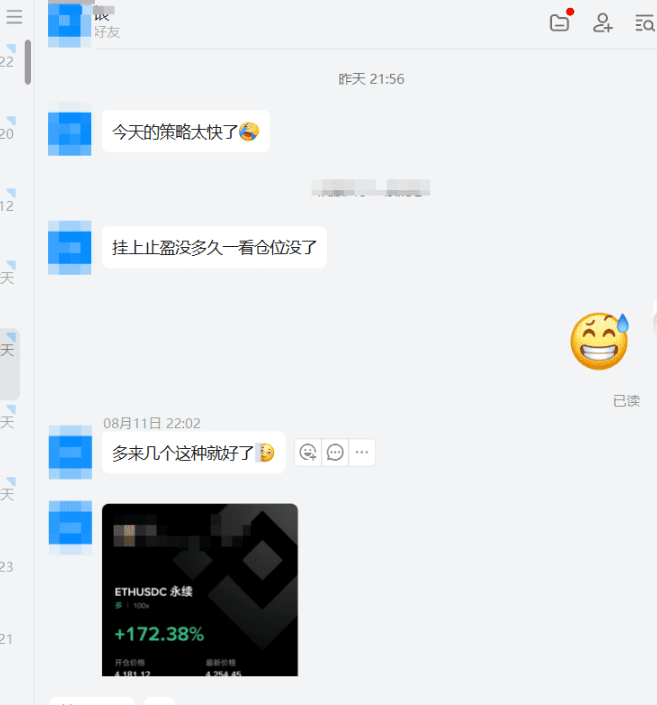
2025 marks my 10th year in the professional crypto trading field. From initially struggling in the crypto world, repeatedly making mistakes, to now achieving a stable profit of seven figures monthly and eight figures annually, what has supported me to this point is not only a deep insight into the market but also a trading system that has been verified thousands of times with a win rate of up to 90%.
Many people ask me what the key to profit is. In fact, last year I gave an answer based on my personal experience — I entered the market with only 50,000 as capital and, relying on this trading strategy honed over the years, not only avoided several market crashes but also achieved explosive growth in funds, ultimately reaching nearly 10 million in scale. This experience made me even more sure that the crypto world is never a place for 'gambling on luck'; only by mastering hardcore techniques and strictly adhering to trading discipline can one stand firm amidst the turmoil.
Today, I am sharing the 10 trading rules I summarized over 10 years. If you are preparing to enter the crypto world or repeatedly losing in investments, I suggest you take 5 minutes to read this carefully — it may help you avoid the pitfalls that have led countless people to bankruptcy and protect your capital and family.
Rule 1: Hold on to low-priced chips and refuse to be 'washed out.'
Truly valuable coins often face the manipulation of 'wash trading' by market makers at low prices. At this time, one must firmly believe in their judgment and not be easily frightened by short-term fluctuations, giving away low-priced chips. Remember, patiently holding onto high-quality low-priced coins is the starting point for profit.
Rule 2: Stay away from all-in operations, learn to build positions in batches.
Chasing after rising prices and panic selling is a common problem among retail investors, and going all in while chasing is an absolute taboo. As long as the overall trend is positive, when encountering a drop in a coin's price, one can instead build a position in batches — this can lower the holding cost and diversify risks, and when the market recovers, the profit potential will be much greater than blindly chasing after rises.
Rule 3: Allocate profits reasonably, do not blindly increase positions.
Many people rush to go 'all in' after making profits, only to lose all profits with a single pullback. The correct approach is: after each profit, first take a portion of the profit to secure it, and then plan the remaining funds based on market conditions to maximize capital efficiency, instead of relying solely on 'increasing positions' for gains.
Rule 4: Withdraw capital during sharp rises, hold coins during sharp falls, and maintain a stable mindset.
When the market rises sharply, first withdraw the principal and use profits to speculate on subsequent fluctuations; when the market drops sharply, if there are no issues with the coin's fundamentals, hold patiently and do not be swayed by panic. Remember: investment is not about 'speed,' but about 'stability' — no speculation, no impatience, no greed, no fear, and do not engage in unprepared battles to go far.
Rule 5: Differentiate between investment stages, do not confuse the main with the secondary.
In the early days, lurking in low-priced coins (or participating in private placements) relied on judging the project's prospects and experience in competing with market makers; after entering the secondary market, one must rely more on technical analysis and information gaps to keep pace with market makers. Many people view the secondary market as a place to 'bet on the future,' neglecting technical analysis, which ultimately leads to more chaos and total loss.
Rule 6: Layered building and liquidating positions to control risk ratio.
Whether it's building a position or liquidating, one must follow the principle of 'layered and segmented'. For example, when building a position, add to it every 5%-10% drop; when liquidating, reduce it every 10%-15% rise, gradually widening the price segments. This effectively controls risk and locks in some profits, avoiding the scenario where 'one wrong step leads to total loss.'
Rule 7: Understand the linkage effect and use tools wisely to gather information.
There are no isolated coins in the crypto world — the trends of mainstream coins will drive the fluctuations of associated altcoins, and industry policies may trigger collective rises and falls in specific track coins; this is the 'linkage effect.' To grasp this rule, one must not only be familiar with the correlation logic of various coins but also make good use of market tools and information platforms to obtain timely updates on coin dynamics and industry news, avoiding misjudgments caused by information gaps.
Rule 8: Reasonably allocate positions to balance risk and return.
The allocation ratio of hot coins and value coins directly determines your risk resistance ability and profit space. Being too conservative, only holding value coins, may lead to missing out on opportunities with hot coins; being too aggressive and fully investing in hot coins may result in losing everything overnight due to severe fluctuations. My advice is to use value coins as the 'base' (accounting for 60%-70%) and use a small amount of funds to participate in hot coin speculation, balancing stability and profit.
Rule 9: The 'three essentials principle' is the safety baseline; investing idle money is fundamental.
Having coins on the market, money in accounts, and cash in pockets is the 'three essentials for safety' in the crypto world. Always remember: going all in will lead to death! Risk control and capital allocation directly determine your mentality and ultimate success or failure. More importantly, always invest with 'idle money' — never use living expenses or mortgage funds to enter the market, as losses could ruin the entire family.
Rule 10: Master the basic logic and learn to summarize independently.
The core of trading is not to 'copy others' strategies' but to grasp the basic ideas and apply them flexibly. For instance, record the key highs and lows after each market fluctuation as references for future judgments; regularly read industry reports and learn technical analysis to gradually develop the ability to filter out effective information and noise. Only by forming your own trading system can you cope with the ever-changing market.
However, in my 10 years of trading experience, I found that the area where retail investors are most likely to stumble is actually 'selling' — many can build positions well but hesitate when 'it’s time to sell,' either missing profit-taking opportunities or watching profits turn into losses. In reality, no one can sell at the highest point every time; the core of selling is not to 'seek the highest' but to 'seek the reasonable.'
For this reason, I have compiled a practical guide from the 'exit techniques' I have repeatedly verified over the past 10 years, with a win rate of over 90%. From judging profit-taking signals to adjusting position sizes, each step has specific methods and cases. This is the essence I summarized after stepping into countless pitfalls, and now I want to share it with more retail investors to help them avoid detours. Update tomorrow @Air 安叔




